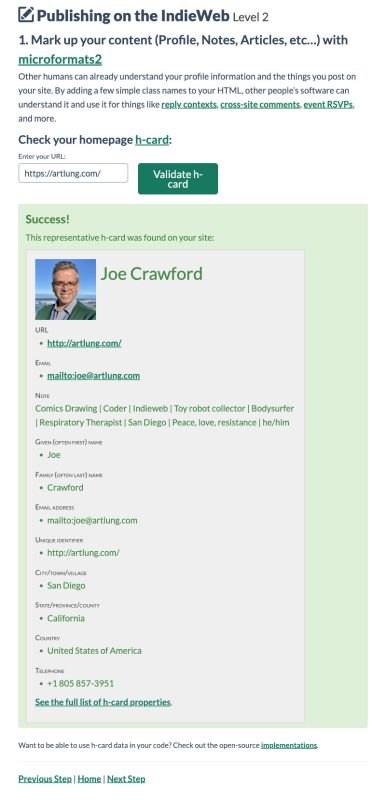I have a FOAF file on this website.
It has a timestamp of Jul 29 2003.
Here’s what’s in it.
<rdf:RDF
xmlns:rdf="http://www.w3.org/1999/02/22-rdf-syntax-ns#"
xmlns:rdfs="http://www.w3.org/2000/01/rdf-schema#"
xmlns:foaf="http://xmlns.com/foaf/0.1/">
<foaf:Person>
<foaf:name>Joe Crawford</foaf:name>
<foaf:firstName>Joe</foaf:firstName>
<foaf:surname>Crawford</foaf:surname>
<foaf:nick>ArtLung</foaf:nick>
<foaf:mbox_sha1sum>06ff9b5ac353498d7ce158b4b03b53bb177160e9</foaf:mbox_sha1sum>
<foaf:homepage rdf:resource="https://artlung.com/blog/"/></foaf:Person>
</rdf:RDF>
What is that. Let’s check the IndieWeb wiki (continually gardened by me and hundreds of IndieWeb members):
FOAF (Friend of a Friend) is (was?) one of the more frequently used RDF vocabularies/formats, in many ways a reinvention of the vCard vocabulary (used in hCard microformats and h-card microformats2).
And the way that was referenced was in the <head> of my site was a header: <link rel="meta" type="application/rdf+xml" title="FOAF" href="/foaf.rdf"> which would in theory would someday cross-link with other people’s FOAF files. It would all constitute a social graph. Then soon enough LinkedIn and MySpace became dominant for that. And we know what happened next. That glorious future of XML dialects inside our sites didn’t happen. It wasn’t useful or practical enough and it was obscurely technical. Without easy and free tools to edit and use RDF it was never going to happen.
Here’s the blog post 20 years ago where I mentioned that I added the file. I suppose it’s telling that the domain “foaf-project.org” which I linked to doesn’t exist anymore.
These days my site communicates similar things with microformats. Microformats are simple enough that a child can use them. Literally on one of the FrESH calls we had a young kid who (with the help of a competent adult) showed off her Glitch web page with recipes marked up with microformats. The barrier to participation is far lower!
And there are great tools like IndieWebify.me and I can check for what my h-card says about me.

h-card is related to hCard is related to vCard, which dates back decades now.
So it’s time to say goodbye to the 1 kilobyte this file has taken up for 20 years.
And if you want to play with code, check out Glitch, it’s fun to code.

one comment...
I hadn’t heard of FOAF before. That’s interesting knowing people have been working on these kinds of things since the early days of the web!